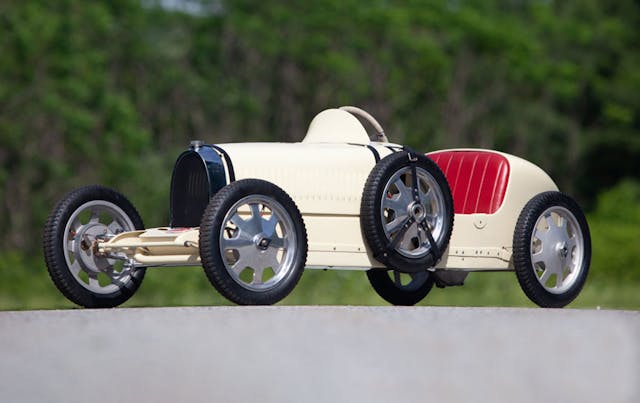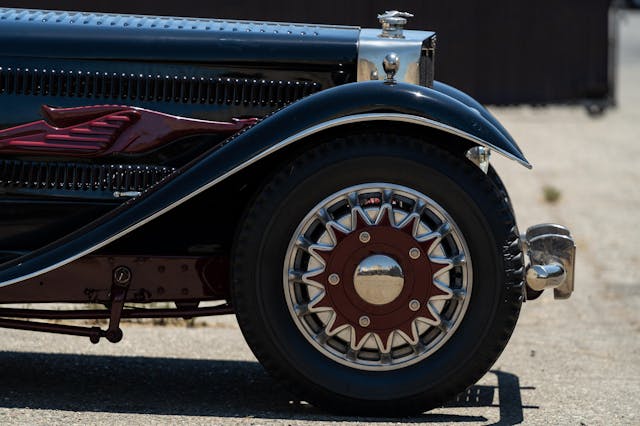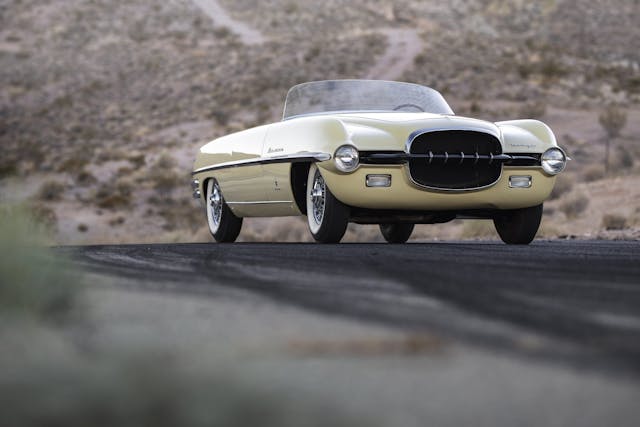7 oddballs keeping it weird at Monterey this year
Monterey Car Week always brings out some of the most valuable cars in the world, but the best part about it might just be the sheer variety of metal that turns up. Both at the shows and the auctions, there are always at least a few things we’ve never seen before or even knew existed. On top of that, seeing such a car cross an auction block and sell to a new owner is often the cherry on top. Each Monterey auction has at least a few quirky, unusual lots on offer, and here are seven that we’ll be sure to size up in person on the peninsula this year.
1954 Glöckler-Porsche 356 Carrera 1500 Coupe

RM Sotheby’s, Lot 236
Estimate: $750,000 – $1,000,000
If you took a blow to the head, closed your eyes and then tried to draw a Porsche 550 Spyder, it might come out looking a little something like this Glöckler-Porsche from 1954. Don’t call it a knockoff, however, because although he never technically worked for Porsche, Frankfurt-based VW/Porsche dealer Walter Glöckler was an important part of the company’s early history in motorsport.
An accomplished racer on both two and four wheels, Glöckler built six Porsche-based specials during the late 1940s and first half of the 1950s. His featherweight aluminum race cars, several of which he converted to run on alcohol, were quick little things. Quick enough to catch the attention of Porsche, which had yet to build a dedicated competition car of its own. When Porsche finally did build its first pure competition model—the 1953 550 Spyder—it took inspiration from Glöckler’s cars.

This funky three-eyed thing was Walter Glöckler’s final Porsche special. Based on a Pre-A 356, it was also his only coupe. In an unusual blend of function over form, there are massive doors that protrude into the roof, presumably to make for easier entry and exit, and a gigantic panoramic rear window for rear visibility. And let’s not neglect those big stubby tailfins.
The coupe was meant to compete in the 1954 Mille Miglia but wasn’t finished in time, so instead it raced at that year’s Liège-Rome-Liège rally. Glöckler’s cousin Helm and Max Nathan co-piloted the car and despite an oil supply issue were just able to nurse it over the finish line. After the rally (its only competition appearance), the Glöckler-Porsche coupe made its way to the U.S. It then spent many years parked at a salvage yard outside of Los Angeles before going back home to Germany for a restoration finished in 2005.
1910 AC Sociable

RM Sotheby’s, Lot 304
Estimate: $30,000 – $40,000
AC is mostly known for lovely ’50s sports cars and for providing the basis for the Shelby Cobra, but the company’s roots go way back to the turn of the century, to a humble little commercial vehicle that’s barely even a car at all.
In 1904, engineer John Weller introduced a low-cost three-wheeled delivery car called the “Auto-Carrier.” Timber-framed and powered by a 636-cc air-cooled single-cylinder with chain drive, the Auto-Carrier featured tiller steering and a cargo box between the front wheels. Simple but effective, it became a popular way to move goods around crowded British cities and towns, so in 1907 a rather cute passenger version called the “Sociable” came about. It was successful, too. The new company soon abbreviated its name to “AC” and the rest, well, is history.
A 1910 two-seater model, the Sociable offered by RM Sotheby’s in Monterey is just one of the seven ACs selling out of the Feldman Collection, which also includes several rare prewar models, a Ruddspeed-powered Ace, and a Frua-bodied 1968 428 Spider. And by the way, although AC has changed owners more times than we care to count, it is technically still around, based in Hethel and building a few versions of the classic Cobra.
1968 BMW-Glas 3000

Mecum, Lot F8
Estimate: $100,000 – $110,000
Once upon a time in the 1960s there was a little Bavarian company called Glas. Glas built microcars (adorably named Goggomobils) and handsome little coupes, such as the 1700 GT and 2600 V8. But Glas also pioneered the use of timing belts on overhead-cam engines, and this little innovation caught the beachball-shaped eye of another Bavarian carmaker: BMW. The larger company absorbed Glas in 1966, and although Glas’s model range gradually faded away, there were a few strange years in there when some Glases got BMW engines and some were even badged as Glas-BMWs. This car offered by Mecum is one of them.
A car with BMW badges but no twin-kidney grilles is weird enough, but underneath it’s really just an updated version of the Glas V8 coupe introduced in 1966. With bodywork penned by Italian designer Pietro Frua, these cars are affectionately referred to as “Glaseratis,” and just 389 of the 3.0-liter cars were built. This one reportedly spent 20 years at the Berlin Auto Museum but has been restored and was imported to the U.S. by a previous owner. It was a $73,000 no-sale on PCarMarket this January and $63,000 no-sale on Bring a Trailer a month later, but maybe this quirky, sort-of BMW in an Italian suit will get more love in Monterey.
1928 Bugatti Type 52 “Bebe”

Gooding & Company, Lot 134
Estimate: $100,000 – $125,000
It may look like a scale replica, but this baby Bugatti is in fact a real Bugatti, baby. Called the Type 52, it’s a half-sized electric version of the famous Type 35 Grand Prix car, and it was the ultimate rich kid Christmas present in the 1920s.
The story goes that Ettore Bugatti designed the first of these “Baby” Bugattis as a one-off for his four-year-old son Roland, but soon put the kiddie-sized racer into production. Powered by a 12-volt electric motor and featuring four-wheel brakes behind alloy wheels, each got a unique Bugatti serial number and the model even appeared in the factory catalogue. Bugatti built about 150 examples before introducing a longer, roomier version, and the Type 52 offered by Gooding & Company is one of the approximately 350 long-wheelbase models.
Only about 100 real Type 52s survive today, according to Gooding (the auction house sold another one for 88 grand a few years ago), but in case you miss out on this one, Bugatti builds a new version called the “Baby II.” Prices range from $36,600 to $71,400.
1954 Dodge Firearrow II by Ghia

RM Sotheby’s, Lot 252
Estimate: $900,000 – $1,200,000
Whether this car is odd-looking or whether it is Jet Age styling at its very best probably depends on whom you ask. In any case, this is one of a series of four concept cars born of the collaboration between Chrysler styling boss Virgil Exner and Carrozzeria Ghia in Italy.
Although Firearrow I was just a static model, Firearrows II-IV were fully functioning cars. They were well-received and showed promise, so one has to wonder if Chrysler could have conceivably built a Firearrow-inspired two-seater to take on the Corvette and Thunderbird. In the end, though, there were just the original four concept cars.
Firearrows II (this car) and IV sold together for $1.1M at Barrett-Jackson Scottsdale in 2007, while RM sold Firearrow III in Monterey 10 years ago for $852,500.
1930 Bucciali TAV 30 “La Marie”

Bonhams, Lot 73
Estimate: N/A
Ever heard of a Bucciali? Don’t worry, neither had I until Bonhams announced it had consigned this example. This will be one of the most obscure cars to ever cross an auction block in Monterey, which is especially weird because it was such a highly advanced and widely publicized car in its day.
Of course, that obscurity might have something to do with the fact that Bucciali wasn’t even a carmaker. Not really, anyway. Brothers Angelo and Paul-Albert Bucciali displayed their cars at the Paris Salon during the late 1920s–30s, but the cars were mainly a showcase for Bucciali’s patented pieces of drivetrain technology. That drivetrain was front-wheel drive, which Bucciali showed off on its stand in Paris in 1926, several years before either the Cord L-29 or Citroën Traction Avant and decades before front-drivers came to dominate our roadways.

The Bucciali brothers reused chassis and swapped out parts, so it isn’t exactly clear how many complete automobiles they made, but the car offered by Bonhams is a one-off nicknamed “La Marie,” featuring a unique four-speed transaxle and four-wheel independent suspension.
Since Bucciali’s main aim was to perfect its front-wheel-drive system and license it to other manufacturers, the brothers took a trip to the U.S. with the car to meet execs at most of the top American carmakers of the day. Willys apparently took extensive notes on the design but didn’t sign a deal. Years later, when Paul-Albert Bucciali noticed some striking similarities between his design and that of the original military Jeep, he sued for patent infringement but lost the case. The only American company to actually sign anything was Peerless, and Peerless was soon to go bust thanks to the Great Depression.
La Marie was also shown at the New York, Chicago, and Paris shows. It wore several different bodies on the show stand and during its tour of America, but after 1931 the bare chassis went into storage and Bucciali stopped building show cars after 1933. It was restored in the ’70s and fitted with a Saoutchik body that had previously been on a Mercedes. The last record we can find of a Bucciali at auction was at the Christie’s Pebble Beach auction way back in 1997, and that car didn’t sell.
1984 Porsche 969 by Rinspeed

Gooding & Company, Lot 11
Estimate: $125,000 – $150,000
Fans of ’80s tuner exotics will be in for a treat at Pebble Beach this year, because running across the block are two Ferraris by Koenig (one Testarossa and one 512 BBi) and this Porsche by Rinspeed.
Rinspeed is a Swiss company founded in the late 1970s by Frank Rinderkecht, and over the past 40-plus years it has built nothing but absolutely outrageous cars, ranging from a utility vehicle with an actual crane in the back to a fully functional Lotus Elise–based electric submarine. Rinspeeds are frequently highlights of the Geneva Motor Show and some of them are just too wacky for words, so after this article you should fire up your Google image search, type in Rinspeed, and prepare to go nuts.
Some of Rinspeed’s more down-to-earth (but still mental) designs are Porsche-based. An early one called the 939 was a flat-nosed convertible based on the 930 Turbo, which came out several years before Porsche sold an open-top 930 of its own. Rinspeed then followed up with this even crazier 969. With flared rear haunches and side strakes, it looks like the love child of a 911 and a Ferrari Testarossa. If you like ’80s gadgetry, don’t miss the interior. The buttons for the power seats are huge and the Pioneer audio system is gigantic, but the best part is that there’s a remote control set into the steering wheel.


